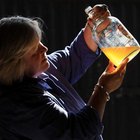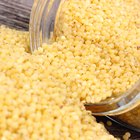
Hard cider is the quintessential fall beverage, the season's best traits -- bottled. With an average alcohol by volume of 6 percent, hard cider pairs well with savory meat dishes and is equally satisfying on its own. You can turn store-bought apple cider into ready-to-drink hard cider in two months using only baking yeast, a few mix-ins and a simple three-stage fermentation process.
Step 1
Prep the oxidizer solution according to package directions. Soak the first-stage jug, the funnel and the stopper airlock in the oxidizer. An overnight soak is recommended. A bathtub or large sink for the actual soaking is ideal. Scrub the inside and outside of the jug and all the implements with a bottle brush.
Step 2
Immerse the jug, the funnel and the stopper airlock in the sanitizer for at least five minutes. Do not rinse. Use immediately, or store the jug and implements in a hot dishwasher until you're ready to do so.
Step 3
Fill the first-stage jug halfway with cider, pouring through the funnel. Combine the room temperature apple juice concentrate, tannin, pectin enzyme and yeast nutrient with the cider. Rehydrate the baking yeast in lukewarm water. Let it sit for five minutes until the yeast blooms.
Step 4
Add the bloomed yeast concoction to the half portion of cider. Shake the jug gingerly to disperse the yeast. Transfer the remaining cider to the jug. Insert the stopper airlock into the jug mouth. Move the jug to a dark space where temperature hovers at 65 to 70 F. Allow fermentation for one to three weeks.
Step 5
Oxidize and sanitize the funnel, the second-stage jug and the cheesecloth. Place the cheesecloth into the funnel like a coffee filter into a brew basket. Set the funnel into the mouth of the jug. Remove the stopper airlock from the first-stage jug. Pour the cider into the second-stage jug.
Step 6
Dunk the airlock stopper into the oxidizer and the sanitizer. Plug up the second-stage jug mouth with the airlock stopper. Allow the cider to “mellow” for one to three weeks. Transfer the cider back to the stage-one jug after three weeks.
Step 7
Put any spices and flavorings you like into the jug using an oxidized/sanitized measuring spoon. Seal the jug and let it settle for another week or two.
Related Articles

How to Make Wine in a Gallon Jug

How to Make Chokecherry Wine

How to Use Bentonite for Clearing Wine

The Danger of Storing Hard Cider in ...

How to Make Sand Plum Wine

How to Mix an Amaretto Sour Drink With ...

How to Make Cranberry Wine

How to Make Wine With Tea

How to Make Merlot Wine

How to Make Pickle-Infused Vodka

How to Measure the Acidity of Homemade ...

How to Clean Stains From False Teeth

How to Get Iron Marks Out of Clothes

How to Pasteurize Homemade Wine

Homemade Sweet Red Wine
How to Ferment Watermelon

How to Make Alcohol at Home

How to Store Homemade Fruitcakes

How to Ferment Whole Grains

Should I Store Red Wine Horizontally or ...
References
Resources
Tips
- If you want to raise the alcohol by volume of your finished hard cider, freeze it and then pour off whatever remains unfrozen. This unfrozen content is almost all alcohol.
- Tweak the flavor of the final batch with high quality artificial flavorings and sweeteners engineered for home brewers and chefs.
Warnings
- Avoid adding sugar to the final batch in an attempt to sweeten or carbonate the hard cider. The residual yeast will eat the sugar, change the cider's flavor and produce enough CO2 to burst the jug open.
Writer Bio
Born in New York City, Tremaine Jackson has been in theater, dance and music since age 12, when he appeared in Liz Swados' "Swing" at the Brooklyn Academy of Music. He is also an award winning children's recording artist. He writes fiction and poetry in his spare time.
Photo Credits
Thomas Northcut/Photodisc/Getty Images